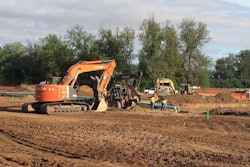
The rate of construction on U.S. homes fell 12.3 percent in June, due to large drops in both single- and multi-family home starts.
According to preliminary data from the Commerce Department, the seasonally adjusted annual rate of residential construction starts fell to 1.173 million units in June, the lowest rate since September 2017 and 4.2 percent below the June 2017 rate.
Single-family home starts fell 9.1 percent to a rate of 858,000 homes, a six-month low and 0.2 percent below the June 2017 rate. Multi-family home starts have dropped 20.2 percent to a rate of 304,000 units, a 12-month low and 15.3 percent below the June 2017 rate.
Though federal numbers on housing starts are frequently subject to major swings and revisions, Bloomberg reports that June’s large drop could signal a slowing within the housing market that is more serious “than previously thought amid constraints for both buyers and developers.”
As we have noted in our construction employment reports, many in the industry are bracing for the potentially wide-ranging impacts of the increased tariffs on imported construction materials initiated by the Trump administration. Homebuilders are obviously not exempt from these worries and some wonder if increased materials costs will soon make it harder to build homes at competitive price points, according to the July NAHB/Wells Fargo Housing Market Index.
Despite the drop and worry over tariffs and costs, builder confidence in the housing market has remained at a “healthy level,” the NAHB reports. The NAHB’s July housing index shows builder confidence unchanged from June at a reading of 68. Any reading above a 50 indicates most home builders believe market conditions are good.
Speaking to Bloomberg, housing analyst and chief investment officer at Hugh Johnson Advisors Hugh Johnson, called the latest home start figures “a one-month glitch,” and predicted that the market will get “somewhat back on track in the coming months, led by an economy that’s expanding, incomes which are expanding, employment which has been surprisingly strong, and although mortgage rates are rising, they’re not rising nearly as fast as they could.”










